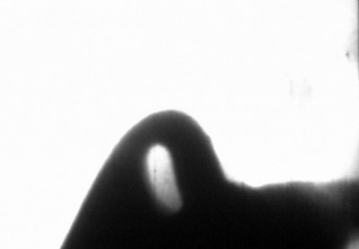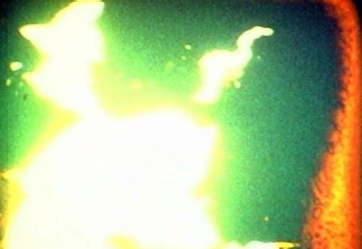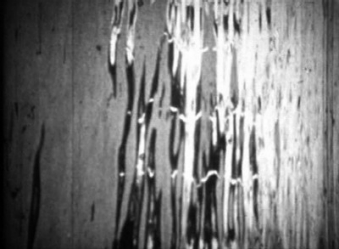Milan Šamec (1942–2007) was a member of a more traditionalist group within the Kino Klub Zagreb that resisted and ridiculed anti-film. Termites was made as a rebuttal of anti-film, a demonstration through which Šamec hoped to take the idea that “anyone can make an experimental film” and bring it to its absurd logical conclusion. To make his film, Šamec exposed film stock unevenly to developer and called the resulting footage of “dancing” spots and specks created by the process “termites” because the spots reminded him of the insects. In order to parody the new music heard at the Zagreb Music Biennale, which was admired by the anti-fil” avant-gardists, Šamec created a sound track by rhythmically tapping and scraping on radiators. Ironically, the result was so visually and aurally impressive that it served as evidence that a parody can sometimes become an homage and can open up a new artistic sensibility despite the author’s original intentions. Indeed, after being shown in Zagreb, Termites was also screened at film festivals in New York, Budapest, and London, and continues, according to Šamec’s obituary to be shown to this day to the students of the Academy of Fine Arts in Zagreb, making it his best-remembered film. — Diana Nenadić
With thanks from the series organizers to Diana Nenadić and the Croatian Film Association (Hrvatski Filmski Savez), Zagreb, for assistance with research for the series and for making a screening of this film possible in Washington.
Banner stills L to R: Encounters, courtesy Croatian Film Association;
Anthony's Broken Mirror and Vowels, courtesy Alternative Film Archive, Academic Film Center, Belgrade
Termites (Termiti)
Milan Šamec, Croatia, 1963, 16 mm transfer to digiBeta, 1 minute 40 seconds

Still from Termites, courtesy Croatian Film Association
Kariokinesis (Kariokineza)
Zlatko Hajdler, Croatia, 1965 (reconstructed 1998), 16 mm transfer to digiBeta, 2 minutes

Still from Kariokinesis, courtesy Croatian Film Association
The film being shown here is a recorded reconstruction of a performance that originally took place at the 1965 Genre Experimental Film Festival (GEFF) in Zagreb. There, Zlatko Hajdler (1939–2009) dragged the East German color film stock ORWO directly in front of the projector lamp, occasionally pressing the film to the lamp and thus causing the film stock to burn gradually, producing spectacular color effects in the process. Conceptually, the idea of making a film by destroying the film stock as it was being projected was truly radical. Like Milan Šamec’s Termites, however, Hajdler meant to show the utter pointlessness of anti-film, which could, so the argument went, be made by anyone. In fact, Hajdler himself was not a director but an amateur cameraman who occasionally worked on recording ethnographic material. Like Šamec, however, what Hajdler ultimately seems to have proven was that others could interpret his attempt at ridicule as an act of liberation from traditional constraints and that it can produce fascinating visual results. This film won the highest awards at the GEFF festival and is the film Hajdler’s is best known for today. He had inadvertently put his finger on the artistic pulse of the time, making work that echoed visually (albeit in a very different context) Gustav Metzger’s auto-destructive art (paintings made with acid that ate away at the nylon canvas), Niki de Saint Phalle’s “shooting paintings,” and Jean Tinguely’s self-destructive machines, all of which were also made in the early 1960s and explored acts of destruction as paths to creation. — Diana Nenadić
With thanks from the series organizers to Diana Nenadić and the Croatian Film Association (Hrvatski Filmski Savez), Zagreb, for assistance in research for the series and for making a screening of this film possible in Washington.
Twist Twist
Ante Verzotti, Croatia, 1962, 16 mm transfer to digiBeta, 2 minutes 20 seconds

Still from Twist Twist, courtesy Croatian Film Association
Ante Verzotti was a member of the Kino Klub Split, whose productions in the early 1960s differed dramatically from the films coming out of the Kino Klub Zagreb. The films made in Split by a diverse array of amateurs were strongly marked by the influence of the poet and architect Ivan Martinac, who favored existentialist themes and a meditative approach to filmmaking while also advocating for so-called editing in frame. Highlighting the importance of the editing process for its own sake, editing in frame suggested that every single frame is crucial for the creation of a unique “cardiogram” of a film.[1]
It also connoted Martinac’s emphasis on time as the most important aspect of film. If time, rather than space, is what film is primarily about, then a “cut” between shots becomes more important than any given shot or scene. According to Martinac, “A huge part of film is in splices, the joints between two frames that remain invisible during the projection. There is more kinaestethic charge in those joints than in the frames themselves.”[2] Unlike Martinac, Verzotti, who was an exception within the Kino Klub Split, was interested in a cinema of proto-abstract patterns, reductionism, and rhythmical orchestration of purely optical and acoustic phenomena. His ideals could best be described as painting with the camera and creating “visual music.” He accomplished them with his debut film Twist-Twist, whose title alludes to the song and dance first popularized in 1960. The film uses the choreography of reflections on the sea’s surface and sets them to the sounds of jazz music. In a later film, Fluorescences (Florescencije) (1967), Verzotti similarly used shaky camera movement to produce abstract rhythmical shapes from various objects, figures, and lights found in the environment through which he was moving. — Diana Nenadić
With thanks from the series organizers to Diana Nenadić and the Croatian Film Association (Hrvatski Filmski Savez), Zagreb, for assistance with research for the series and for making a screening of this film possible in Washington.
1. Martinac was so dedicated to his ideas that he regularly counted with great precision the exact number of frames in his films and cited their duration “in frame” (e.g., 7’ 32’’, 11 frames). (back to top)
2. Ivan Martinac, “Martinac,” in 41 godina filmskog stvaralaštva, 1960–2001 (Split, 2001). (back to top)
